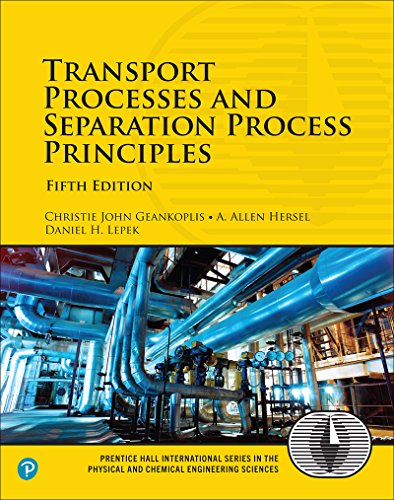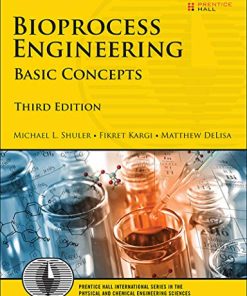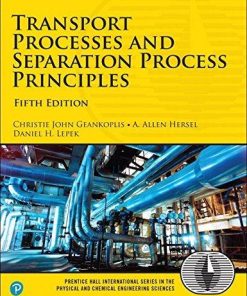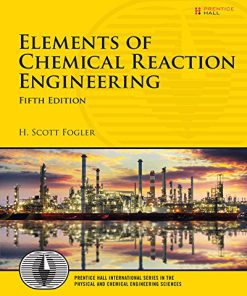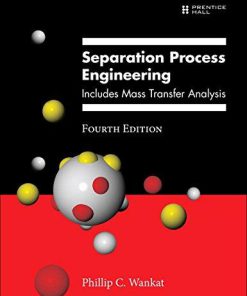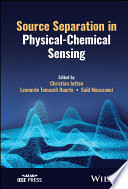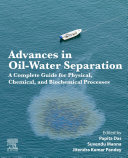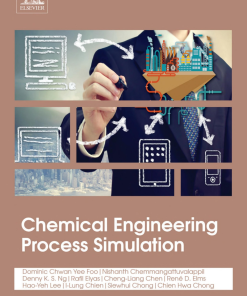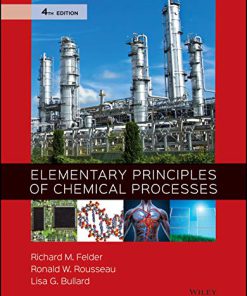Transport Processes and Separation Process Principles (Prentice Hall International Series in the Physical and Chemical Engineering Sciences) 5th Edition, (Ebook PDF)
$50.00 Original price was: $50.00.$25.00Current price is: $25.00.
Transport Processes and Separation Process Principles (Prentice Hall International Series in the Physical and Chemical Engineering Sciences) 5th Edition, (Ebook PDF) – Digital Instant Dowload.
Transport Processes and Separation Process Principles (Prentice Hall International Series in the Physical and Chemical Engineering Sciences) 5th Edition, (Ebook PDF) – Digital Instant Dowload.
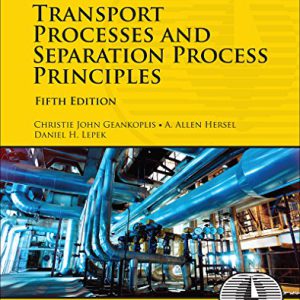
Product details:
- ISBN-10 : 0134181026
- ISBN-13 : 978-0134181028
- Author: Christie John Geankoplis
Transport Processes and Separation Process Principles, Fifth Edition, offers a unified and up-to-date treatment of momentum, heat, and mass transfer and separations processes. This edition–reorganized and modularized for better readability and to align with modern chemical engineering curricula–covers both fundamental principles and practical applications, and is a key resource for chemical engineering students and professionals alike.
Table contents:
Part 1: Transport Processes: Momentum, Heat, and Mass
- Introduction to Engineering Principles and Units
- Chapter Objectives
- Classification of Transport Processes and Separation Processes (Unit Operations)
- SI System of Basic Units Used in This Text and Other Systems
- Methods of Expressing Temperatures and Compositions
- Gas Laws and Vapor Pressure
- Conservation of Mass and Material Balances
- Energy and Heat Units
- Conservation of Energy and Heat Balances
- Numerical Methods for Integration
- Chapter Summary
- Introduction to Fluids and Fluid Statics
- Chapter Objectives
- Introduction
- Fluid Statics
- Chapter Summary
- Fluid Properties and Fluid Flows
- Chapter Objectives
- Viscosity of Fluids
- Types of Fluid Flow and Reynolds Number
- Chapter Summary
- Overall Mass, Energy, and Momentum Balances
- Chapter Objectives
- Overall Mass Balance and Continuity Equation
- Overall Energy Balance
- Overall Momentum Balance
- Shell Momentum Balance and Velocity Profile in Laminar Flow
- Chapter Summary
- Incompressible and Compressible Flows in Pipes
- Chapter Objectives
- Design Equations for Laminar and Turbulent Flow in Pipes
- Compressible Flow of Gases
- Measuring the Flow of Fluids
- Chapter Summary
- Flows in Packed and Fluidized Beds
- Chapter Objectives
- Flow Past Immersed Objects
- Flow in Packed Beds
- Flow in Fluidized Beds
- Chapter Summary
- Pumps, Compressors, and Agitation Equipment
- Chapter Objectives
- Pumps and Gas-Moving Equipment
- Agitation, Mixing of Fluids, and Power Requirements
- Chapter Summary
- Differential Equations of Fluid Flow
- Chapter Objectives
- Differential Equations of Continuity
- Differential Equations of Momentum Transfer or Motion
- Use of Differential Equations of Continuity and Motion
- Chapter Summary
- Non-Newtonian Fluids
- Chapter Objectives
- Non-Newtonian Fluids
- Friction Losses for Non-Newtonian Fluids
- Velocity Profiles for Non-Newtonian Fluids
- Determination of Flow Properties of Non-Newtonian Fluids Using a Rotational Viscometer
- Power Requirements in Agitation and Mixing of Non-Newtonian Fluids
- Chapter Summary
- Potential Flow and Creeping Flow
- Chapter Objectives
- Other Methods for Solution of Differential Equations of Motion
- Stream Function
- Differential Equations of Motion for Ideal Fluids (Inviscid Flow)
- Potential Flow and Velocity Potential
- Differential Equations of Motion for Creeping Flow
- Chapter Summary
- Boundary-Layer and Turbulent Flow
- Chapter Objectives
- Boundary-Layer Flow
- Turbulent Flow
- Turbulent Boundary-Layer Analysis
- Chapter Summary
- Introduction to Heat Transfer
- Chapter Objectives
- Energy and Heat Units
- Conservation of Energy and Heat Balances
- Conduction and Thermal Conductivity
- Convection
- Radiation
- Heat Transfer with Multiple Mechanisms/Materials
- Chapter Summary
- Steady-State Conduction
- Chapter Objectives
- Conduction Heat Transfer
- Conduction Through Solids in Series or Parallel with Convection
- Conduction with Internal Heat Generation
- Steady-State Conduction in Two Dimensions Using Shape Factors
- Numerical Methods for Steady-State Conduction in Two Dimensions
- Chapter Summary
- Principles of Unsteady-State Heat Transfer
- Chapter Objectives
- Derivation of the Basic Equation
- Simplified Case for Systems with Negligible Internal Resistance
- Unsteady-State Heat Conduction in Various Geometries
- Numerical Finite-Difference Methods for Unsteady-State Conduction
- Chilling and Freezing of Food and Biological Materials
- Differential Equation of Energy Change
- Chapter Summary
- Introduction to Convection
- Chapter Objectives
- Introduction and Dimensional Analysis in Heat Transfer
- Boundary-Layer Flow and Turbulence in Heat Transfer
- Forced Convection Heat Transfer Inside Pipes
- Heat Transfer Outside Various Geometries in Forced Convection
- Natural Convection Heat Transfer
- Boiling and Condensation
- Heat Transfer of Non-Newtonian Fluids
- Special Heat-Transfer Coefficients
- Chapter Summary
- Heat Exchangers
- Chapter Objectives
- Types of Exchangers
- Log-Mean-Temperature-Difference Correction Factors
- Heat-Exchanger Effectiveness
- Fouling Factors and Typical Overall U Values
- Double-Pipe Heat Exchanger
- Chapter Summary
- Heat Exchangers
- Chapter Objectives
- Types of Exchangers
- Log-Mean-Temperature-Difference Correction Factors
- Heat-Exchanger Effectiveness
- Fouling Factors and Typical Overall U Values
- Double-Pipe Heat Exchanger
- Chapter Summary
- Introduction to Radiation Heat Transfer
- Chapter Objectives
- Introduction to Radiation Heat-Transfer Concepts
- Basic and Advanced Radiation Heat-Transfer Principles
- Chapter Summary
- Introduction to Mass Transfer
- Chapter Objectives
- Introduction to Mass Transfer and Diffusion
- Diffusion Coefficient
- Convective Mass Transfer
- Molecular Diffusion Plus Convection and Chemical Reaction
- Chapter Summary
- Steady-State Mass Transfer
- Chapter Objectives
- Molecular Diffusion in Gases
- Molecular Diffusion in Liquids
- Molecular Diffusion in Solids
- Diffusion of Gases in Porous Solids and Capillaries
- Diffusion in Biological Gels
- Special Cases of the General Diffusion Equation at Steady State
- Numerical Methods for Steady-State Molecular Diffusion in Two Dimensions
- Chapter Summary
- Unsteady-State Mass Transfer
- Chapter Objectives
- Unsteady-State Diffusion
- Unsteady-State Diffusion and Reaction in a Semi-Infinite Medium
- Numerical Methods for Unsteady-State Molecular Diffusion
- Chapter Summary
- Convective Mass Transfer
- Chapter Objectives
- Convective Mass Transfer
- Dimensional Analysis in Mass Transfer
- Mass-Transfer Coefficients for Various Geometries
- Mass Transfer to Suspensions of Small Particles
- Models for Mass-Transfer Coefficients
- Chapter Summary
Part 2: Separation Process Principles
- Absorption and Stripping
- Chapter Objectives
- Equilibrium and Mass Transfer Between Phases
- Introduction to Absorption
- Pressure Drop and Flooding in Packed Towers
- Design of Plate Absorption Towers
- Design of Packed Towers for Absorption
- Efficiency of Random-Packed and Structured Packed Towers
- Absorption of Concentrated Mixtures in Packed Towers
- Estimation of Mass-Transfer Coefficients for Packed Towers
- Heat Effects and Temperature Variations in Absorption
- Chapter Summary
- Humidification Processes
- Chapter Objectives
- Vapor Pressure of Water and Humidity
- Introduction and Types of Equipment for Humidification
- Theory and Calculations for Cooling-Water Towers
- Chapter Summary
- Filtration and Membrane Separation Processes (Liquid–Liquid or Solid–Liquid Phase)
- Chapter Objectives
- Introduction to Dead-End Filtration
- Basic Theory of Filtration
- Membrane Separations
- Microfiltration Membrane Processes
- Ultrafiltration Membrane Processes
- Reverse-Osmosis Membrane Processes
- Dialysis
- Chapter Summary
- Gaseous Membrane Systems
- Chapter Objectives
- Gas Permeation
- Complete-Mixing Model for Gas Separation by Membranes
- Complete-Mixing Model for Multicomponent Mixtures
- Cross-Flow Model for Gas Separation by Membranes
- Derivation of Equations for Countercurrent and Cocurrent Flow for Gas Separation by Membranes
- Derivation of Finite-Difference Numerical Method for Asymmetric Membranes
- Chapter Summary
- Distillation
- Chapter Objectives
- Equilibrium Relations Between Phases
- Single and Multiple Equilibrium Contact Stages
- Simple Distillation Methods
- Binary Distillation with Reflux Using the McCabe–Thiele and Lewis Methods
- Tray Efficiencies
- Flooding Velocity and Diameter of Tray Towers Plus Simple Calculations for Reboiler and Condenser Duties
- Fractional Distillation Using the Enthalpy–Concentration Method
- Distillation of Multicomponent Mixtures
- Chapter Summary
- Liquid–Liquid Extraction
- Chapter Objectives
- Introduction to Liquid–Liquid Extraction
- Single-Stage Equilibrium Extraction
- Types of Equipment and Design for Liquid–Liquid Extraction
- Continuous Multistage Countercurrent Extraction
- Chapter Summary
- Adsorption and Ion Exchange
- Chapter Objectives
- Introduction to Adsorption Processes
- Batch Adsorption
- Design of Fixed-Bed Adsorption Columns
- Ion-Exchange Processes
- Chapter Summary
- Crystallization and Particle Size Reduction
- Chapter Objectives
- Introduction to Crystallization
- Crystallization Theory
- Mechanical Size Reduction
- Chapter Summary
- Settling, Sedimentation, and Centrifugation
- Chapter Objectives
- Settling and Sedimentation in Particle–Fluid Separation
- Centrifugal Separation Processes
- Chapter Summary
- Leaching
- Chapter Objectives
- Introduction and Equipment for Liquid–Solid Leaching
- Equilibrium Relations and Single-Stage Leaching
- Countercurrent Multistage Leaching
- Chapter Summary
- Evaporation
- Chapter Objectives
- Introduction
- Types of Evaporation Equipment and Operation Methods
- Overall Heat-Transfer Coefficients in Evaporators
- Calculation Methods for Single-Effect Evaporators
- Calculation Methods for Multiple-Effect Evaporators
- Condensers for Evaporators
- Evaporation of Biological Materials
- Evaporation Using Vapor Recompression
- Chapter Summary
- Drying
- Chapter Objectives
- Introduction and Methods of Drying
- Equipment for Drying
- Vapor Pressure of Water and Humidity
- Equilibrium Moisture Content of Materials
- Rate-of-Drying Curves
- Calculation Methods for a Constant-Rate Drying Period
- Calculation Methods for the Falling-Rate Drying Period
- Combined Convection, Radiation, and Conduction Heat Transfer in the Constant-Rate Period
- Drying in the Falling-Rate Period by Diffusion and Capillary Flow
- Equations for Various Types of Dryers
- Freeze-Drying of Biological Materials
- Unsteady-State Thermal Processing and Sterilization of Biological Materials
- Chapter Summary
Part 3: Appendixes
- Appendix A.1 Fundamental Constants and Conversion Factors
- Appendix A.2 Physical Properties of Water
- Appendix A.3 Physical Properties of Inorganic and Organic Compounds
- Appendix A.4 Physical Properties of Foods and Biological Materials
- Appendix A.5 Properties of Pipes, Tubes, and Screens
- Appendix A.6 Lennard-Jones Potentials as Determined from Viscosity Data
- Notation
- Index
You may also like…
Chemistry - History of Chemistry
Source Separation in Physical-Chemical Sensing Christian Jutten
Engineering


